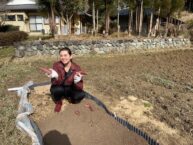I switched my CIP for the last few months of my time at KCJS, away from the Animation and Voice Study Group and into another circle called NASA (not about space). The Animation and Voice Study group met in a designated club room on Doshisha’s campus, every single day from a little after noon when one of the key holders arrived and until 7-8 pm. There aren’t many formal club activities, and for the semester I studied in, there was only one event scheduled in November concerning a voice actor interview. As the for the latter circle, NASA has regular meetings at Monday and Tuesday lunchtime and Thursday afternoon. The room for these meetings is decided on the day of and sent to everyone in the LINE group by the time a free classroom is found. There are also occasional spontaneous outings, where invitations are handled similarly through LINE.
Honestly, when I first read that this program required you to go out and find a way to participate in the community, I was nervous. I’ve never actively sought out conversation and prefer to be left alone half of the time, if not more. Therefore, when I first starting searching for a CIP, I thought it would be simple enough to find a circle at Doshisha, or another university, that dealt with manga/anime/games, which was one of the driving reasons I wanted to learn Japanese in the first place. After learning that the gaming circles that responded to me were monthly meetings, and that I knew I couldn’t draw well enough to keep up with doujinshi circles, I thought I found a suitable CIP in the Animation and Voice Study Group. I had read in a previous one of these blogs that this circle was fairly free-form and casual, without set days, and I valued flexibility in setting up my own pace of engagement.
What I ended up realizing was that the clubroom was a place to relax, passing time through talking with friends, playing the various consoles or board games, or reading manga from the shared library or whatever books a member decided to bring on a particular day. Despite a good first CIP assessment, where I talked with the club president and a few others for an hour, I ended up falling into a routine that was counter-productive to the purpose of engaging in a CIP. I would walk in on a free day (if I hadn’t come before a member who could open the door, in which I would go home for the day), greet everyone with an “お疲れ様です”, stare at my phone half-heartedly as I worked up the nerves to strike up even a few minutes’ worth of conversation so I could say I learned something, realize I mostly wasted an hour or more doing nothing productive, and leave the room with everyone saying another “お疲れ様です”.
I can’t say if it was due to looking like I was peacefully reading, my poor social conversation skills, if the other members were as nervous as I was, or some combination of the above and unmentioned factors, but I ended up in my usual position of being alone in a room of people. I would answer a question of two, I’d try to interject in a conversation or two if I could actually understand and had something halfway interesting to say and try to scrounge up some reflection of Japanese culture by the time I decided to leave. By the time I decided to stop, I learned about the traditional “お疲れ様です” greeting, that people mostly talked with pre-formed groups, that conversations wouldn’t stop or dampen even when someone was asleep, and that the guys grouped around the playmat whereas the girls sat around the table. Honestly, if I were to transcribe everything that I felt I learned, more than half of that report would be the rules of the Power Grid board game.
When I was going over some of these grievances with Nakamura-sensei, she suggested that I switched CIPs, a suggestion that made me feel dumb about trying to salvage something that I was barely participating in. This is how Kyle, a fellow classmate, got roped into introducing me and a few others to the NASA group.
Within the very first meeting, through non-stop interactions with people whose purpose in coming to the club was to talk with foreign students, I came to multiple realizations about everyday conversation: about people who would always confirm “私ですか” even if the conversation had been one-to-one the entire time, about how people are understanding and flexible about switching between short form and ‘desu/masu’ form, about Japanese understanding on English words and the difficulty of perceiving a verb as a noun or vice versa (impacting, a fail), and even about how strong anti-piracy views concerning anime and movies (which I only got an impression of previously).
As a recommendation to any future extreme introverts with social anxiety, I would suggest trying to get outside of your normal comfort zone. I know that CIP is encouraged to be aligned with your interests, but it can be very easy to use that comfort as a crutch. I’m sure you’ve read through other blogs saying how the club members here are all very accommodating, and that can also work as a negative if you’re uncomfortable with social interaction and they pick up on that. Try volunteering and working with people who are happy that you’re there, introducing yourself to a new craft like crocheting or music, or finding a group that genuinely just wants to get to know you and your friends like NASA is for me. Maybe you don’t have to go as far out of your comfort zone as I do, or that your interests have a clearer objective with an active subculture and a dynamic vocabulary, but make sure to find a CIP where you won’t have any regrets about missed opportunities. Take it from someone with a few of his own.

